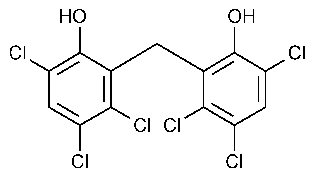Hexachlorophene
Phenol,2,2¢-methylenebis[3,4,6-trichloro-.
2,2¢-Methylenebis[3,4,6-trichlorophenol] [70-30-4].
»Hexachlorophene contains not less than 98.0percent and not more than 100.5percent of C13H6Cl6O2,calculated on the dried basis.
Packaging and storage—
Preserve in tight,light-resistant containers.
Identification—
A:
Infrared Absorption á197Kñ.
B:
To a solution of about 5mg in 5mLof alcohol add 1drop of ferric chloride TS:a transient purple color is produced immediately.
Loss on drying á731ñ—
Dry it at 105 for 4hours:it loses not more than 1.0%of its weight.
for 4hours:it loses not more than 1.0%of its weight.
Residue on ignition á281ñ:
not more than 0.1%.
Limit of 2,3,7,8-tetrachlorodibenzo-p-dioxin—
[Caution—Since 2,3,7,8-tetrachlorodibenzo-p-dioxin is an extremely toxic substance,exercise all necessary precautions in the conduct of this procedure.
]Dissolve 10.0g of Hexachlorophene in 50mLof methanol,transfer to a 1-Liter separator with the aid of 25mLof methanol,add 25mLof 2.5Nlithium hydroxide and 225mLof water,and extract with two 200-mLportions of freshly distilled n-hexane.Dry the combined n-hexane extracts over anhydrous sodium sulfate,filter,and evaporate to a volume of about 15mLon a rotary evaporator at a bath temperature not exceeding 40 .Transfer this solution in portions to a 12-mLcentrifuge tube,concentrating each time to a volume of 1mLin a gentle stream of nitrogen in a warm water bath.Rinse the flask with 15mLof n-hexane,and evaporate similarly.Wash down the walls of the tube with 10mLof n-hexane,and again evaporate to a volume of 1.0mL.Cool,and transfer to a micro-column that has been prepared in the following manner.Place a small plug of glass wool in a 5-×15-mm pipet,add a small amount of sand and 1.0g of basic alumina,tap several times to pack down the alumina,and heat in a vacuum oven at 110
.Transfer this solution in portions to a 12-mLcentrifuge tube,concentrating each time to a volume of 1mLin a gentle stream of nitrogen in a warm water bath.Rinse the flask with 15mLof n-hexane,and evaporate similarly.Wash down the walls of the tube with 10mLof n-hexane,and again evaporate to a volume of 1.0mL.Cool,and transfer to a micro-column that has been prepared in the following manner.Place a small plug of glass wool in a 5-×15-mm pipet,add a small amount of sand and 1.0g of basic alumina,tap several times to pack down the alumina,and heat in a vacuum oven at 110 for 3hours.Store under vacuum.
for 3hours.Store under vacuum.
Elute the column with 10mLof a mixture of n-hexane and methylene chloride (9:1),using a portion to rinse the tube.Collect the eluate in a 12-mLgraduated centrifuge tube,and concentrate in a gentle stream of nitrogen in a warm water bath to a volume of 1.0mL.
Inject 2.0µLof the concentrated eluate into a suitable gas chromatograph connected to a mass spectrograph equipped with a multiple-ion detector (see Chromatography á621ñand Mass Spectrometry á736ñ).The gas chromatograph is fitted with a 2-mm ×1-m glass column containing liquid phase G1on support S1.The carrier gas is helium,flowing at the rate of 40mLper minute.The column temperature is maintained at 250 and the injection port is maintained at 300
and the injection port is maintained at 300 .Similarly inject 2.0µLof a Standard solution of 2,3,7,8-tetrachlorodibenzo-p-dioxin containing 0.01µg per mL.*The sum of the peak heights at mass values of 320,322,and 324obtained from the solution under test is not greater than the sum of the peak heights at the same mass values obtained from the Standard solution.The limit is 1ppb.
.Similarly inject 2.0µLof a Standard solution of 2,3,7,8-tetrachlorodibenzo-p-dioxin containing 0.01µg per mL.*The sum of the peak heights at mass values of 320,322,and 324obtained from the solution under test is not greater than the sum of the peak heights at the same mass values obtained from the Standard solution.The limit is 1ppb.
Assay—
Accurately weigh about 1.5g of Hexachlorophene,dissolve in 25mLof alcohol,and titrate with 0.1Nsodium hydroxide VS,determining the endpoint potentiometrically.Perform a blank determination,and make any necessary correction.Each mLof 0.1Nsodium hydroxide is equivalent to 40.69mg of C13H6Cl6O2.
*
Asolution in anisole is available commercially from KOR Isotopes,Div.of ECO,Inc.,56Rogers St.,Cambridge,Mass.02142.This solution may be diluted with a mixture of n-hexane and methylene chloride (9:1)to the required concentration.
Auxiliary Information—
Staff Liaison:Behnam Davani,Ph.D.,MBA,Senior Scientist
Expert Committee:(PA7)Pharmaceutical Analysis 7
USP28–NF23Page 943
Phone Number:1-301-816-8394
